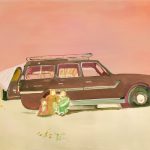Tabari Artspace is delighted to announce Seham, the solo exhibition of emerging Emirati artist, Almaha Jaralla. Jaralla’s mixed media works on canvas pioneer new notions of the conventional portrait. For Jaralla, architecture is, for example, a concrete portrait of a society, one that offers her endless sources of inspiration. For her first solo exhibition at Tabari Artspace, Almaha Jaralla invites the audience to join her on a journey through Abu Dhabi’s constructed and social worlds from the 1980s until the present day.
For Seham, the visual artist has produced a series of mixed media works on canvas that depart from the artist’s own archival family portraits taken in Abu Dhabi during the 1980s. Jaralla understands these intimate portraits as a window into the essence of the city during a period of rapid social and physical transformation in the Gulf. Jaralla’s work highlights the familial dynamics of that era, a moment when parks and beaches were key physical spaces that shaped the community, and when large family outings were commonplace. The artist suggests that the pre-digital era was a time when in-person contact, time spent as a collective and inter-generational bonds were more prolific then the individualism that she witnesses today. Jaralla’s work establishes a sense of connection to the past while foregrounding the dramatic evolution of the city that she inhabits today.
One work takes Abu Dhabi’s Al Maqtaa Bridge as its subject matter and embodies a sense of connection between past/present, and tradition/ modernity. Built in 1968, the Al Maqta Bridge was the first structure to connect Abu Dhabi Island to the mainland. Highlighting the shift in pace that Jaralla seeks to capture before the arrival of the bridge island residents patiently waited for low tide to arrive before making their way to the mainland. The initiation of the Al Maqta Bridge was a game-changer, it significantly improved transportation links and connected Abu Dhabi to the rest of the UAE. It represented a pivotal moment in the city’s development that Jaralla reflects upon today.
The title of the show, Seham, translates from Arabic to English as “arrows”. Seham is also the name of Jaralla’s aunt, an influential figure that has shaped the artist’s life and work; Seham’s influence is now celebrated in this exhibition. Much like Jaralla, Seham documented her surroundings obsessively with a Fuji camera, a process which helped her to amass the impressive family archive that Jaralla now draws from in her paintings. The red filter revealed by Seham’s Fuji camera informs the palette used in Jaralla’s paintings. The hues absorbed from the desert landscape, regional fashions and the architecture of the UAE in the 1980s are also reflected in her compositions.
Jaralla’s oil paintings are loaded upon unconventional canvases that the artist has fashioned from traditional men’s garments referred to as Maawaz. The designs originate from Aden and materialise the artist’s desire to foreground the cultural and historical value of Yemeni heritage. The patterns and textures of the Maawaz contribute an unexpected visual element to Jaralla’s paintings and establish a dynamic interplay between tradition and modernity.
In addition to the 2-dimensional works on display the gallery space will be transformed into an immersive setting where visitors might sit and contemplate the significant shifts that have impacted the region over the decades.
“This particular exhibition takes my aunt, Seham’s, name as the title in tribute to her influence. The exhibition explores Abu Dhabi’s geographic topography and the transformations that have taken place over time, from the perspective of a personal journey. By using the name “Seham” and its translation “Arrows” in the title, I aim to convey the direction and movement associated with arrows. The title also serves to connect a personal journey with the wider context of the city’s transformation over time.” – Almaha Jaralla, 2023
Press release from Tabari Artspace



